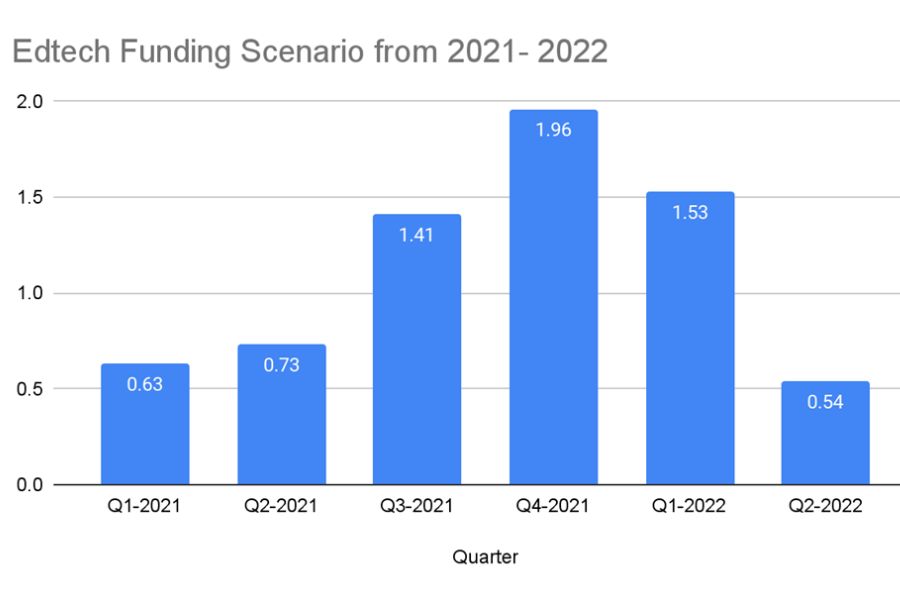Still sunny days for edtech post-pandemic?
The coping phase of the education system during the two-year-long pandemic has evolved with time. With over 1.6 billion students exposed to remote learning and virtual classrooms, teaching methods have changed. As the pandemic is slowly fading and we are gearing up to get back to our pre-pandemic lives, the transition brought to the state of edtech is likely to persist.
- The growth of edtech in India has remained slow yet steady for the past two years.
- Edtech principles and methods have evolved during the pandemic, but have not been entirely efficient in substituting physical learning.
- The cost, accessibility and availability of online teaching are the primary challenges. With around 748 million Indians using smartphones by 2020, a large population is yet to understand the nitty-gritty of edtech.
- Online education platforms like Byju’s and Unacademy are all set to flourish in the coming years. The market value of edtech platforms in India is estimated to grow up to INR 360 billion by 2024.

The edtech sector in India rose to prominence at the onset of the pandemic, which is almost a decade after its establishment. Though the concept of online teaching was growing and developing in the country, the pandemic exposed our education system to e-learning modules. While the effectiveness of the edtech sector has not been equitable in every part of the country, the work is in progress for the rural areas. So, edtech startups, companies and the Government of India are taking every possible initiative to develop a systematic procedure where students can learn through a wide range of e-learning programmes. Let us consider a few facts that draw the overall progress of edtech companies since the pandemic.
Edtech funding in India
The funding landscape in India has been seeing a fall since the start of the year, as the after effect of the pandemic. Notably, the Q2 funding of 2022 crashed by about 50% and has plummeted from US$ 915 million as of Q1 2022 to US$ 456 million in Q2 2022. The following graph analyses the funding scenario from 2021 to 2022 based on the total funding amount of edtech startups in India across the quarters:

Source: Inc42 (Note: The above data is updated till June 2022.)
The graph states that from Q1 2021 to Q2 2022, the funding scenario has seen sharp fluctuations. The deal count stood at over 36 massive deals in the first quarter, which fell to mere 24 deals across the major startups in the edtech sector. The major edtech companies like Byju’s, Unacademy and Vedanta have been fighting rumours of layoffs as of the last quarter. As per the reports, funding to Vedanta has dipped by 37% in Q2.
However, if we dig deep, amidst this sour season for the edtech industry in India, there has been a high start for some of the edtech startups in India. Recently, the two major edtech startups, UpGrad and PhysicsWallah have closed top-notch deals. It is to be noted that UpGrad managed to crack a deal of US$ 250 million and managed to double its valuation in the present quarter, while PhysicsWallah has raised US$ 100 million in Series A funding.
Effectiveness of Edtech across India
When the world education system was forced to go online as schools were shut, the effectiveness of e-learning methods was questionable. Edtech companies have played a major role in bridging these gaps. As reports revealed, around 80% of schools in India lacked technical support and internet when education went online in 2020.
As the ecosystem has evolved over the two years, this condition has improved substantially. Government aids and edtech learning campaigns have monitored online learning in different parts of the country. The CAGR (compound annual growth rate) for online course enrolment has observed a 17 times growth in 2021.
However, the socioeconomic divide is playing its role in creating a disparity in the growth of edtech in India. While students from urban areas have increasingly participated in online learning programmes, rural children are yet to become tech-friendly. Technology and high-speed internet connection facilities are yet to set foot in many parts of the country. Many schools have also reported the challenges faced by the teaching staff with digital literacy.
Since most people in rural villages have never had the required exposure to advanced digital devices required for conducting online classes, bringing a reform for the growth of edtech in India is quite challenging. Nonetheless, the efforts made by the government in bringing digital awareness are yielding fruits steadily. Several edtech startups have also been introduced since the onset of the pandemic to overcome these challenges. Edtech platforms like ConveGenius, ThinkZone, Eduaura and Veative Labs provide cost-effective learning facilities to unprivileged groups of the society who cannot afford costly subscriptions. All these services have allowed bottom-line students to acquire education at home.
Ongoing efforts to promote edtech companies
Indian edtech firms are making global success and progress. Indian edtech organisations have raised over US$ 2.3 billion in funding as of the first half of 2021. So, leading firms and edtech startups are succeeding in creating greater student involvement in digital learning.
The government of India has taken 28 digital initiatives to promote e-learning methods, including SWAYAM (Study Webs of Active Learning for Young Aspiring Minds) and e-Yantra. All these government initiatives are running in full force in different parts of the country. Further, the e-Vidya (one class, one TV channel) programme – launched by the government – aims at offering an ‘education for all’ service to students. A digital university was also launched in Union Budget 2022. It is a way of promoting the importance of educational technology in India. Besides, the DESH-Stack e-portal is a skill development ecosystem launched by the government to provide certification courses on API (Applications Programming Interface). The development of e-labs is also in progress to promote critical thinking in mathematics and science.
With these programmes, digital campaigns and promotions in effect, it is clear that India is aiming for the long-term growth of edtech. The only biggest challenge is explaining the benefits of e-learning to people who have been accustomed to the traditional methods of learning for generations. Government schools are yet to undergo modernization with sufficient computers and internet access installed on the premises. Teachers’ training programs, innovative mechanisms and regional content are highly required in these areas for considerable development. The initiatives taken by edtech companies in this case are highly credible. As it pans out, urban cities in India are likely to embrace all these new transitions made to the education system, while rural areas are yet to welcome the new techniques wholeheartedly.
Heading to a Steady Progress
As schools in India have partially opened for students to come and acquire offline lessons, the impact of e-learning is still active. Many schools have created an online streaming portal for students to participate in the class. Online lessons for junior classes are still actively running in many schools. Administrative work has undergone complete online modification. At the same time, rural students are also preached the importance of educational technology.
Modern schools in urban areas are pledging technologically advanced services. The vision of developing digital classrooms is finally in motion as educational institutes are moving forward to enhance their teaching methods and techniques. The support of edtech companies in promoting online tutoring services and courses has begun to yield results.
As for the challenges in rural areas, numerous startups and edtech firms are taking government initiatives forward with central funding. Students from hill stations, rural cities and remote areas are finally getting the required exposure as schools and universities are now welcoming online study programmes along with offline courses. The enrolment rate in distance learning programmes has also increased considerably over the past couple of years. As per reports, 11% of the total enrolment in higher education is credited to distance learning courses.
Online education is likely to synchronise at a good compatible rate with the return to physical mode. Every recognised school and university is setting examples with their modified programmes that include online assignment submission, webinars, seminars and PTM meetings. The need for student migration is reducing for the greater good. With equitable digital resources, the face of the Indian education system would change in the years to come!
Lastly, the government and collaborative organisations need to contribute towards building a more dynamic ecosystem for the growth of edtech. The role of parents should be clearly highlighted in promoting online learning. Two-way interaction should be encouraged in virtual classes for edtech efforts to be successful. The intention to promote skill-based online learning will be effective only if the basic requirements are met. Needless to say, the question of whether online learning is a feasible possibility or not has been answered in the past two years.













Leave a comment